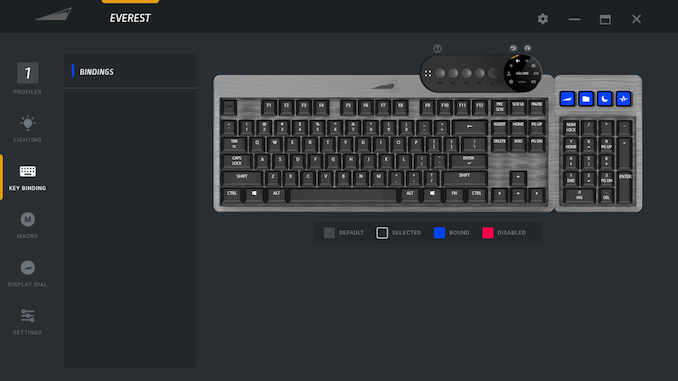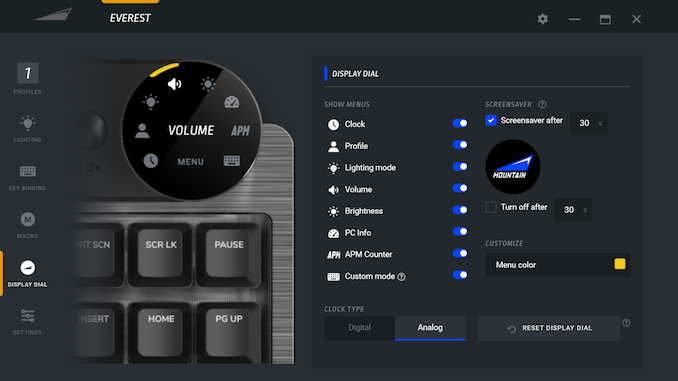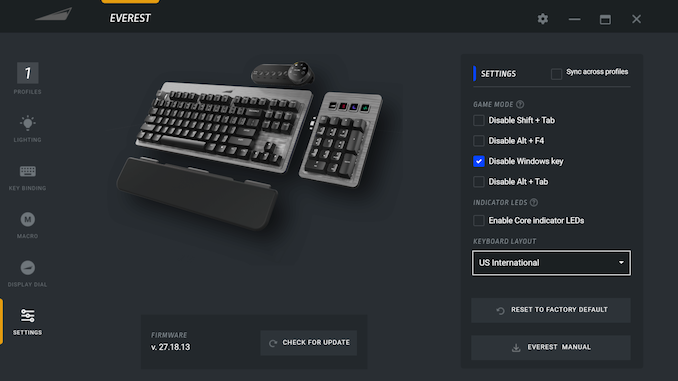The Mountain Everest Max Mechanical Keyboard Review: Reaching New Heights in Build Quality
by E. Fylladitakis on November 17, 2021 10:45 AM EST- Posted in
- Peripherals
- Cherry MX
- Mechanical Keyboards
- Mountain
Software: The BaseCamp App
A good software suite is always the heart behind a really advanced mechanical keyboard. Mountain named their software BaseCamp, a fitting name for a company that clearly likes naming things after, well, mountains. Unlike the single-page software packages we usually encounter, BaseCamp is a complex piece of software with a clean user interface and tons of customization options. It also supports the customization of and synergy with other Mountain products, or will support them in the future. The current version also supports syncing with Razer products.
Once the Everest keyboard is selected, the first customization page is the profile customization and management page. This page is relatively simple, allowing the users to create, duplicate, import, export, and delete custom profiles. We found one limit here, which is that there can only be up to five profiles, which may or may not be enough for active gamers and multidisciplinary professionals.
The second page of the software allows for lighting programming. It is relatively simple to program the lighting effects per profile, with several pre-programmed visual effects already present. If a pre-programmed effect is selected, the user can adjust its direction and speed. Per-key manual programming is also possible. The software also offers synchronization between devices and other profiles.
Moving to the third page of the software, users here can reprogram any key to either change its function or disable it altogether. Aside from simple layout changes, users can also tether advanced functions, keystrokes, or even complete macros to every single key.
Naturally, the next page of the software is the Macro programming page. The Macro recorder is intuitive but not the most advanced we have seen to this date. It allows for the recording of keyboard and mouse keystrokes but cannot record or perform mouse movements. Users can also adjust or negate action delays, as well as to modify the playback mode of the macro. There also is an option to test the programmed macro.
The next page allows for the customization of the display dial on the media dock – assuming there is one attached. Users can select the options that appear on its rotating menu, how long it remains active, and some basic colors. There also is a custom mode that allows advanced users to achieve some personalization. The downside is that, if the display is not set to stay on constantly, it resets itself back to the main menu. This can be annoying for some users, especially those who want to use it purely for sound volume control, as they need to go in the menu, select volume, and then adjust the volume – every single time.
The final page of the software is simple, yet important. From here users can modify the “game mode” of the profile, disabling specific keys. They also can disable the indicator LEDs entirely, as well as change the entire keyboard’s layout. Finally, there is an option to automatically check for and update the keyboard’s firmware.


















54 Comments
View All Comments
COtech - Friday, November 19, 2021 - link
Sounds like quite a product for a first attempt. $200 is out of my budget range but not crazy for high-end boards with Cherry switches and good software.As well as they did out of the gate, and with the report that one software issue observed has already been fixed, I'm sure they'll get the other minor things fixed in the next revision.
COtech - Friday, November 19, 2021 - link
They are asking $70 for the media dock alone so it makes sense to get the Max package straight off rather than start with the core and build.zlandar - Friday, November 19, 2021 - link
Wish someone would make a real successor to the Logitech G15. I like having the lcd display with Sirreal applet running.Short_Circuit - Friday, November 19, 2021 - link
Funny you say that. The original G15 is the last 'specialty' keyboard I bought prior to the Everest.Back when the iCue Nexus was announced I was considering one of those + a K100 as a potential equivalent, but the Nexus, in the flesh, was a bit disappointing for the price (primarily for the very low screen vs bezel ratio). If/when Corsair brought out an improved version of that (or the cost of the current one reduced by a margin), I'd probably stick one on the back of my Everest for the best of all worlds.
Don't forget that there are a variety of other options for small, keyboard-mounted displays, albeit many have a DIY aspect to them. Nextion HMI displays are ideal for this.
stjoes123@gmail.com - Thursday, November 25, 2021 - link
Anandtech once again made a very compelling write up why this Mountain Everest keyboard system is top notch and worthy of purchase. As a result I ordered one as I was tired of going thru another Corsair mechanical keyboard. As I type this post I have 3 broken Corsairs all for failed Cherry MX Red switches. Sounds like a simple fix right? .... anyone who has completed a replacement Cherry switch on any of the Corsair keyboards knows it's not a quick repair but involves not only soldering but removal of dozens of tiny phillips head screws. Me, I'm tired of spending hours making this type repair versus a simple Mountain Everest keyboard switch replacement which takes only a few minutes to complete. This alone is worth this purchase.Short_Circuit - Monday, January 17, 2022 - link
It's with a heavy heart that I'm back to make a follow-up to previous comments praising the keyboard.Unfortunately, six weeks of experience has demonstrated that while my opinion of the hardware hasn't changed, it remains a lovely keyboard to work on, my view of the firmware and software has, drastically - for the worse.
After the intial setup I have found a growing number of glitches with the keyboard, the most serious of which is that since a firmware update, the Media Dock refuses to wake up after system standby or hibernation - unless it (or the entire keyboard) is physically disconnected/reconnected every time.
Furthermore, it occasionally goes non-functional when the system is up, too. And when this happens it somehow interferes with communication between the keyboard and its mating software service.
The automatic, app launch profile switching doesn't work consistently, and, most frustratingly, after being advised to re-flash the firmware and then factory reset the keyboard by Mountain TS, re-importing my saved settings didn't re-import custom per-key per-app lighting profiles I'd previously set up.
The macro recording process is exceptionally cumbersome and difficult to edit too.
To be fair, Mountain support have been quick to respond to emails, but beyond asking for (and me providing) a large amount of detailed info and system logs, they haven't yet been able to make any suggestions. Since looking around, I've found a significant number of other users reporting issues too.
I have, ironically, found the keyboard is more reliable and less glitchy with the Base Camp service disabled on the host PC.
Hopefully these problems are related to the firmware and software and can be fixed in short order. If I don't hear anything back from Mountain over the next couple of weeks, it'll be a very reluctant call to the place I bought it to enquire about a refund.
dreamslacker - Wednesday, January 19, 2022 - link
Have you tried using a powered USB 3 hub to connect the keyboard and also using a USB 3 host port? If you haven't, try using a powered USB 3.0 hub and re-flash the keyboard.Also, with regards to the media dock or keypad, do keep these connected to the main kb module before connecting the kb to the hub/ computer.
I've found that when using a USB 2.0 host port on my KVM (but keeping the keyboard powered via the hub), configuring the keyboard is extremely slow; and firmware updates are impossible (despite that the keyboard controller only runs at USB 1.1 internally).
I've the same experience with Base Camp and Mountain support as well - fast response, generally polite, but basically their only response is equivalent to "Have you tried restarting/ re-installing?".
Short_Circuit - Friday, January 21, 2022 - link
Hi dreamslacker, thanks for the comment. Unfortunately I think I've got all those bases covered already.Unfortunately I had the keyboard connected to a powered internal USB3 hub when I first got it. And ironically I think it masked some of the keyboard's problems as the hub powered down when the system went to S3/S4/S5 - and resulted in the Everest cold-booting itself every time the computer resumed.
I've since built up a new Z690 box and the keyboard is now connected directly to the motherboard's USB3.2 rear ports - and so the keyboard receives power all the time.
I'm an embedded developer too so I'm mildly tempted to sniff the connection between the dock/numpad and the keyboard to see how they communicate. I'm presuming it'll either be SPI or UART - do you happen to know anything more on that?
That said, I bought the keyboard to work with, not work *on*, and if it continues to irk me, it'll be going back. Unfortunately.
dreamslacker - Friday, January 21, 2022 - link
Hi Short_Circuit, unfortunately, I do not know what kind of protocol is used for the connection between the main module and the media dock.That said, when I did the tear down to pad the keyboard, I did notice that the media dock daugther card uses a 14 pin SMD connection to interface with the main module PCB.
Assuming the buttons (5) and encoder are using 7 pins as GPIO, that leaves 2 pins for power/ common GND and 5 pins for other communication. Since I didn't open up the media dock, I couldn't say if they had use a separate MCU with I2C internally to run the OLED or if they had use SPI/ I2C to run the display module directly (since some OLEDs will have their own display IC).
Another interesting thing I noted is that when I did the teardown on the numpad to put the poron pads, I did see that the programmable buttons display uses a single large OLED display - they simply refresh the 4 cut-out portions on the display and have to refresh the entire matrix everytime a change is made.
Short_Circuit - Saturday, January 22, 2022 - link
Thanks.The reason I intially suspected that there is a satellite MCU in the dock is primarily due to the way the keyboard behaves after the MMD fails to 'wake up'. If there was a simple electrical connection between the MMD transport control buttons/rotary encoder and the main Holtek MCU, theoretically the buttons and encoder should still function normally even when the display fails. That isn't what happens.
In my case, when the MMD fails to wake up (or seemingly goes to sleep after the system is up), the buttons and encoder fail to function and remain so until the MMD is removed/reconnected to reboot it. Looking at the logs created by the Boot Camp software reinforces this notion too.
In any case, if as you say there is a 14 pin connection (vs the 20 theoretically available via the USB-C connector), and we were to assume that the main MCU is running everything, that theoretically doesn't leave enough to have the five buttons, the encoder, four status LEDs, power and ground as well as some form of data channel to the dock's display.
Re power draw, I can see why a USB 2.0 hub wouldn't cut it. I've just put a meter on mine and though it's fine with the LEDs off, it will go right up to nudging the USB 3.0/3.1 4.5W limit with the illumination set to full white at maximum brightness.
Incidentally did you actually see enough of the numpad's display to confirm that it is an OLED device? I keep seeing people say that but Mountain don't describe it as an OLED, and from the colour shift across different viewing angles and the black levels, it looks more like an LCD than anything else.